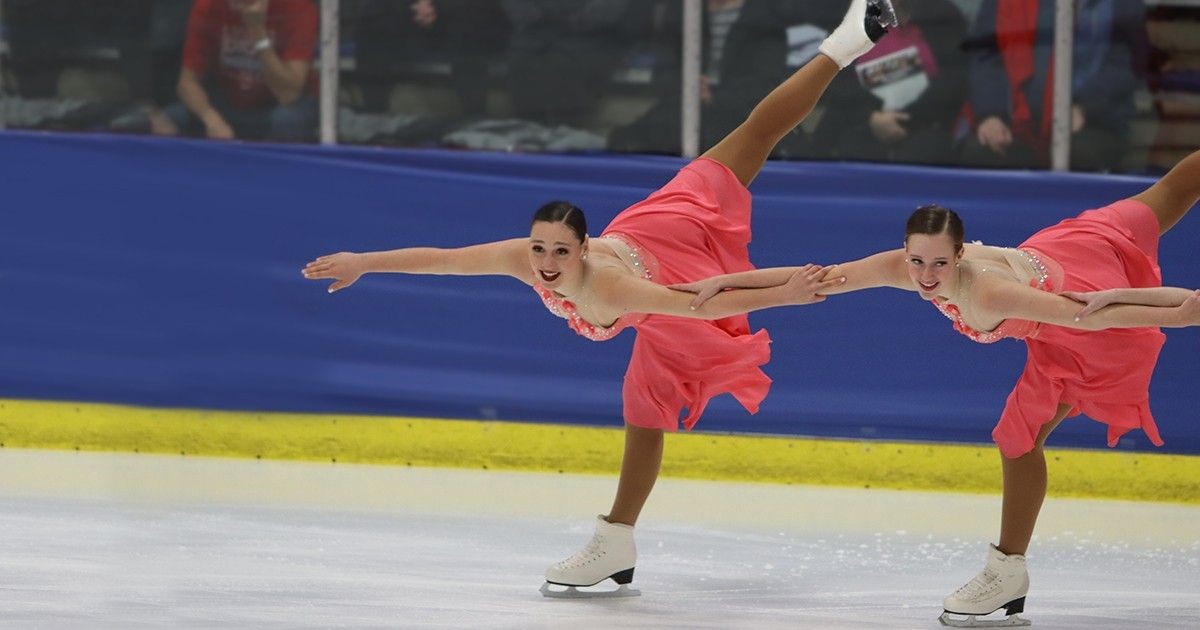Synchronized Skater Balances Babson Academics with Olympic Dreams

As a Weissman Scholar at Babson College, and Team USA synchronized skater, Laura Nicula ’24 does not have much free time. She also has no complaints.
“I love it. There’s no other way to explain it,” Nicula said. “I look forward to practice every day. This is what I love to do. I honestly wouldn’t rather be anywhere else. I like waking up in the morning and seeing all of my teammates, who are my best friends, who are also working so hard. It’s really inspiring.”
Nicula skates on the Haydenettes, the top synchronized skating team in the country. They have won 11 consecutive U.S. championships and 28 overall. The Haydenettes wear the Team USA jacket and are assigned by U.S. Figure Skating, the sport’s governing body, to represent the United States at international events against the best competition in the world.
“They’ve been the best for as long as many people can remember,” Nicula said.
The Haydenettes practice at the Skating Club of Boston’s brand-new $67 million skating facility in Norwood, Massachusetts. It boasts three ice surfaces, including an Olympic-size ice sheet with 2,500 upholstered seats, an overhead scoreboard, a Bose sound system, and an extraordinary range of amenities.
Nicula is the youngest member of her team, which ranges in age from 18 to 24. Most attend college full time in the area, including her Babson classmate, Elissa Kempisty ’23. Others work full time, or have plans for graduate school.
“Synchronized skating, especially at this level, is really a major time commitment.”
Laura Nicula ‘24
Nicula’s ultimate goal is to skate in the 2026 Winter Olympics in Milan and Cortina, Italy. But, first, synchronized skating has to be accepted into the Olympics as an Olympic sport. The good news is that efforts have been well underway for the last six years, and there’s a good chance it—and Nicula’s dreams—will become a reality.
But, first, there’s work to be done.
Skating and Studying
Nicula started figure skating when she was 3, and switched to synchronized skating at age 9. She skated at the junior level for the St. Louis Synergy in her hometown of St. Louis, Missouri, setting her sights on her sport’s pinnacle. After much effort, she made the Haydenettes. And, with her team placement confirmed, and her acceptance to Babson in hand, Nicula headed off to Boston for college and the best team in the United States.
On a typical Wednesday, Nicula, who lives on campus, wakes up at 5:30 a.m. and is out the door by 5:55. She practices from 6:30 to 10:30, returns to Babson, eats lunch, and attends class from 2 to 7:30 p.m.
She juggles her sport, studies, schedule, and Babson’s rigorous academics with the grace one would expect from a synchronized skater. Yet, Nicula also recognizes the challenges and demands of being a Team USA athlete while attending a top-tier business school.
“Synchronized skating, especially at this level, is really a major time commitment,” she said. “We have four- to seven-hour practices four times a week with the team. And, sometimes it’s difficult to manage the Babson course load, along with skating practices.”
Sometimes, she will stay later at the rink to study, or she’ll get to the rink early to do homework. Because classes are in person and online, she also sometimes attends her classes virtually at the rink. The Skating Club of Boston has homework rooms within their complex, another amenity that allows them to attract top global talent.
Now in her second semester at Babson, Nicula studies, practices, and works toward getting her sport accepted into the Olympic Games.
An Olympic-Sized Objective
U.S. Figure Skating held the first U.S. Synchronized Skating Championships in 1984, and the first World Synchronized Skating Championships in 2000. Today, there are about 600 registered synchronized teams in the United States. Competitions use the same judging system as singles, pairs, and ice dance, and are judged on skating skills, transitions, performance, composition, interpretation, and difficulty of elements. With eight to 16 skaters performing on the ice together, synchronized skating is considered unique because of its incredible teamwork, speed, and intricate formations.
There has been an established movement to get synchronized skating into the Olympics since after the Sochi Games in 2014. One of the obstacles is that synchronized skating teams have too many people, according to the International Olympic Committee (IOC), posing logistical and monetary challenges. To solve that, an idea has surfaced for synchronized skating to reboot, with smaller teams and fewer skaters on the ice, in the hopes of showcasing a winning idea. The IOC has expressed interest in this approach, and the work continues.
In July 2022, the world will find out if synchronized skating will be in the 2026 Olympic Games, when the IOC announces its decision.
Nicula and her teammates have discussed starting an Olympic Committee—an organization dedicated solely to synchronized skating and the Olympics—to try to push for her sport to be in the Olympics with even more energy and focus than ever before.
As a member of the Haydenettes, and Team USA, she recognizes their huge platform, and opportunity, to be able to share their sport with the world.
“That’s in the works,” Nicula said, “and it’s definitely something that we’re going to want to do this semester going forward.”
So far, Nicula is making the most of her time—on and off the ice.
Posted in Community





